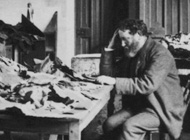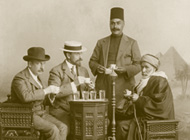|
The Bible has been called the best-selling book of all time, though the term itself comes from biblia, Greek for a collection of books. The Bible developed gradually, over many centuries, as the result of cultural interaction and exchange among many different societies. Over time, some texts were accepted as part of the canon of belief, while others were excluded as apocryphal and heretical. Out of this rich diversity and cultural complexity emerged the modern Bible.
In the Beginning: Bibles Before the Year 1000 tells the story of this formative period. The exhibition brings together a rare assemblage of several important early Hebrew and Christian bibles—the first time many of these fragile treasures have been shown to the public. This exploration of the Bible's first thousand years also reveals the parallel development of the book—one of the world's great technological revolutions.
From fragile fragments of papyrus and humble early parchment codices to resplendent illuminated manuscripts, In the Beginning presents the physical evidence of the earliest versions of both Bible and book. Some of these manuscripts have remained in ancient monastic libraries or cathedral treasuries since they were written. Others have languished, concealed in desert caves, sealed up in long-forgotten rooms, or buried to await resurrection by archaeologists. Each has its own distinctive a tale to tell.
The quest to discover ancient biblical manuscripts
The Christian concept of the Bible was established long before many of its earliest materials were discovered in the Middle East. It was only in the nineteenth century that European and American explorers, archaeologists, and others made their way to Egypt, seeking to learn how the Bible was transformed into a complex symbol of faith.
Exciting finds included the Cairo Genizah, associated with the thousand-year-old Ben Ezra Synagogue. A genizah was a sealed room where copies of scripture with scribal errors were stored until they could be ritually destroyed. In 1896–98, Cambridge University academics Solomon Schechter and Charles Taylor shipped the bulk of the Cairo Genizah's contents to Cambridge for further research; some of those fragments are exhibited in this gallery. Photographs taken at the time convey the excitement of the scholars who were the first to study these long-lost works.
The role of American collectors
A number of collectors felt the thrill of the chase for biblical manuscripts, and they relished the clandestine negotiations surrounding their purchases. "I am a little in doubt as to the wisdom of letting it be known...that I anticipate visiting Egypt," explained Detroit industrialist Charles Lang Freer, "as one can never measure the competition that may spring up if it is known a real search is being made for rareties."
Freer's 1906 purchase of early biblical manuscripts from Ali Arabi, a dealer in Giza, Egypt, includes two substantially complete Greek codices dating from the late fourth or early fifth century. One contains the books of Deuteronomy and Joshua and the other the Freer Gospels, also known as Codex Washingtonensis—one of the earliest versions of the Greek Bible. Freer also acquired codices of the Psalms, the Epistles of Paul, and, in 1916, the Minor Prophets. He even bought an early Coptic bookstand on which such volumes would originally have been displayed. Freer's collection of manuscripts remains the most important of its kind outside the Middle East and Europe.
The American mining engineer Alfred Chester Beatty was a prominent collector of early biblical materials, many of which he purchased from Egyptian dealers. Consequently, the find sites of these items are unknown, though most are thought to have come from the Fayyum (an area southwest of Cairo). Beatty's collection, now housed in Dublin Castle, includes twelve important early Christian codices dating from the third to fourth century: their discovery was announced in The Times of London on November 17, 1931.

|
 |
Click on an image for details:

Solomon Schechter, Cambridge University Library, 1898
 Charles Lang Freer in Egypt
Charles Lang Freer in Egypt
|